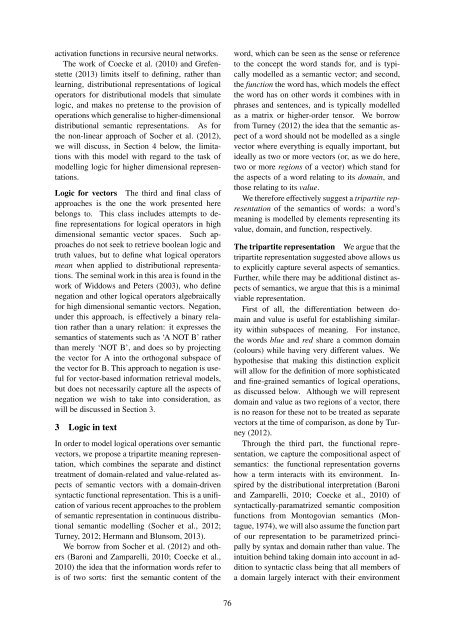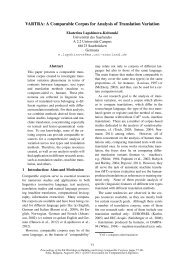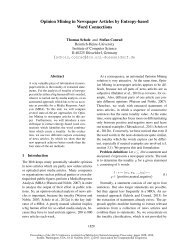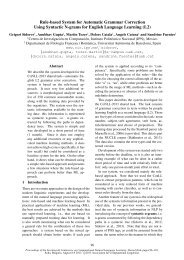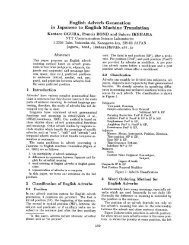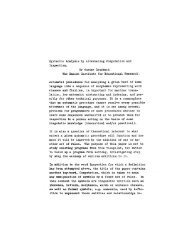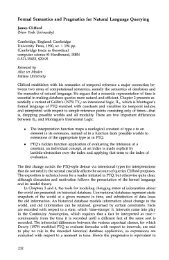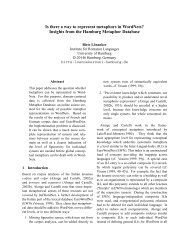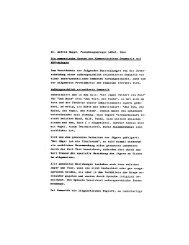Vector Space Semantic Parsing: A Framework for Compositional ...
Vector Space Semantic Parsing: A Framework for Compositional ...
Vector Space Semantic Parsing: A Framework for Compositional ...
Create successful ePaper yourself
Turn your PDF publications into a flip-book with our unique Google optimized e-Paper software.
activation functions in recursive neural networks.<br />
The work of Coecke et al. (2010) and Grefenstette<br />
(2013) limits itself to defining, rather than<br />
learning, distributional representations of logical<br />
operators <strong>for</strong> distributional models that simulate<br />
logic, and makes no pretense to the provision of<br />
operations which generalise to higher-dimensional<br />
distributional semantic representations. As <strong>for</strong><br />
the non-linear approach of Socher et al. (2012),<br />
we will discuss, in Section 4 below, the limitations<br />
with this model with regard to the task of<br />
modelling logic <strong>for</strong> higher dimensional representations.<br />
Logic <strong>for</strong> vectors The third and final class of<br />
approaches is the one the work presented here<br />
belongs to. This class includes attempts to define<br />
representations <strong>for</strong> logical operators in high<br />
dimensional semantic vector spaces. Such approaches<br />
do not seek to retrieve boolean logic and<br />
truth values, but to define what logical operators<br />
mean when applied to distributional representations.<br />
The seminal work in this area is found in the<br />
work of Widdows and Peters (2003), who define<br />
negation and other logical operators algebraically<br />
<strong>for</strong> high dimensional semantic vectors. Negation,<br />
under this approach, is effectively a binary relation<br />
rather than a unary relation: it expresses the<br />
semantics of statements such as ‘A NOT B’ rather<br />
than merely ‘NOT B’, and does so by projecting<br />
the vector <strong>for</strong> A into the orthogonal subspace of<br />
the vector <strong>for</strong> B. This approach to negation is useful<br />
<strong>for</strong> vector-based in<strong>for</strong>mation retrieval models,<br />
but does not necessarily capture all the aspects of<br />
negation we wish to take into consideration, as<br />
will be discussed in Section 3.<br />
3 Logic in text<br />
In order to model logical operations over semantic<br />
vectors, we propose a tripartite meaning representation,<br />
which combines the separate and distinct<br />
treatment of domain-related and value-related aspects<br />
of semantic vectors with a domain-driven<br />
syntactic functional representation. This is a unification<br />
of various recent approaches to the problem<br />
of semantic representation in continuous distributional<br />
semantic modelling (Socher et al., 2012;<br />
Turney, 2012; Hermann and Blunsom, 2013).<br />
We borrow from Socher et al. (2012) and others<br />
(Baroni and Zamparelli, 2010; Coecke et al.,<br />
2010) the idea that the in<strong>for</strong>mation words refer to<br />
is of two sorts: first the semantic content of the<br />
word, which can be seen as the sense or reference<br />
to the concept the word stands <strong>for</strong>, and is typically<br />
modelled as a semantic vector; and second,<br />
the function the word has, which models the effect<br />
the word has on other words it combines with in<br />
phrases and sentences, and is typically modelled<br />
as a matrix or higher-order tensor. We borrow<br />
from Turney (2012) the idea that the semantic aspect<br />
of a word should not be modelled as a single<br />
vector where everything is equally important, but<br />
ideally as two or more vectors (or, as we do here,<br />
two or more regions of a vector) which stand <strong>for</strong><br />
the aspects of a word relating to its domain, and<br />
those relating to its value.<br />
We there<strong>for</strong>e effectively suggest a tripartite representation<br />
of the semantics of words: a word’s<br />
meaning is modelled by elements representing its<br />
value, domain, and function, respectively.<br />
The tripartite representation We argue that the<br />
tripartite representation suggested above allows us<br />
to explicitly capture several aspects of semantics.<br />
Further, while there may be additional distinct aspects<br />
of semantics, we argue that this is a minimal<br />
viable representation.<br />
First of all, the differentiation between domain<br />
and value is useful <strong>for</strong> establishing similarity<br />
within subspaces of meaning. For instance,<br />
the words blue and red share a common domain<br />
(colours) while having very different values. We<br />
hypothesise that making this distinction explicit<br />
will allow <strong>for</strong> the definition of more sophisticated<br />
and fine-grained semantics of logical operations,<br />
as discussed below. Although we will represent<br />
domain and value as two regions of a vector, there<br />
is no reason <strong>for</strong> these not to be treated as separate<br />
vectors at the time of comparison, as done by Turney<br />
(2012).<br />
Through the third part, the functional representation,<br />
we capture the compositional aspect of<br />
semantics: the functional representation governs<br />
how a term interacts with its environment. Inspired<br />
by the distributional interpretation (Baroni<br />
and Zamparelli, 2010; Coecke et al., 2010) of<br />
syntactically-paramatrized semantic composition<br />
functions from Montogovian semantics (Montague,<br />
1974), we will also assume the function part<br />
of our representation to be parametrized principally<br />
by syntax and domain rather than value. The<br />
intuition behind taking domain into account in addition<br />
to syntactic class being that all members of<br />
a domain largely interact with their environment<br />
76


